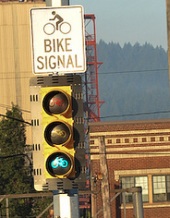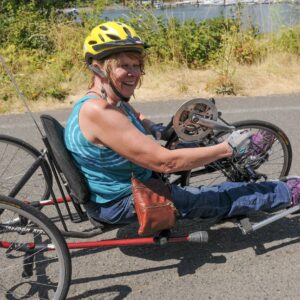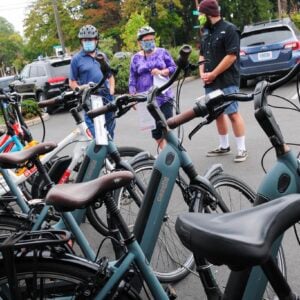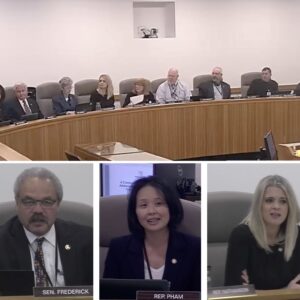
agenda in Salem today.
(Photo © J. Maus)
The Oregon State Legislature is getting down to business this week and there’s a bike-related bill that’s already getting some action. Senate Bill 130 (text) would add green, yellow and red bicycle signals to Oregon’s list of officially accepted traffic control devices. The Oregon Department of Transportation (ODOT) is behind the bill and it’s being supported by the City of Portland, the Bicycle Transportation Alliance, and others.
Peter Koonce, Signals and Street Lighting Division Manager for the City of Portland Bureau of Transportation (PBOT) is in Salem today to testify in support of the bill at a work session of the Senate Committee on Business, Transportation and Economic Development.
I caught up with Koonce this morning to find out more about what’s in the bill and what’s at stake for bicycling.
“We have used bike signals to remove confusion and improve safety of our streets… They give road users better information than what they have today.”
— Peter Koonce, PBOT
Koonce wants the bill to pass because it would give him and other signal engineers throughout Oregon more leeway in using bicycle signals. Currently, bicycle signals are not included in the Manual on Uniform Traffic Control Devices (MUTCD) — the federal manual that dictates what type of traffic controls can legally be used on our roadways. The feds are currently considering the addition of bicycle traffic signals to the MUTCD, but that process is still underway.
In the meantime, Koonce says, traffic signal law is full of grey areas. “If you look at the law, it’s questionable whether or not violations of bicycle signals are enforceable… Because the bike symbol, per se, is not recognized in statute.” The legal grey area isn’t the only problem. Engineers throughout the state are less-inclined to install bike signals without the endorsement (and legal protection that comes with it) of the MUTCD.
Lack of recognition in Oregon and federal law hasn’t stopped PBOT from using bike signals. PBOT installed the city’s first bike signal at N. Interstate and Oregon (just above the Eastbank Esplanade) way back in 2004. Bike signals are also in operation at E Burnside and 41st and more recently at Broadway and N. Williams.
Portland isn’t the only city that wants bike signals to get an official endorsement. Koonce says engineers in the City of Ashland (in southern Oregon) have also proposed one, but without an Oregon law in place, they’d have to go through the lengthy process of requesting an “experiment” to use them through the Federal Highway Administration (FHWA).
If SB 130 passes, state law would have precedence over the MUTCD and traffic engineers throughout Oregon would have the green light to install them.
In Salem today, Koonce intends to share with legislators that use of bicycle signals would improve Oregon’s traffic operations. “We have used bike signals to remove confusion and improve safety of our streets… They give road users better information than what they have today.” Koonce adds that the new law would simply articulate what they’re already doing. “The bill basically codifies a technique we have used for years.”
SB 130 was introduced by ODOT, a fact Koonce says, makes its chances of passing much more likely. “The fact that ODOT is taking a leadership role on this issue helps us.” The Bicycle Transportation Alliance (BTA) is also expected to testify in support of the bill.
Stay tuned for more coverage of this and other legislative efforts. Read past coverage of the 2011 Legislative Session here.





I love the bike signals. It takes a bit get used to when I first moved here, but it definitely puts most drivers and cyclists in order. They should invest and build more of them around Portland.
Could someone clarify how these bike specific traffic signals are being used? Are they being used specifically for bike lanes and MUP’s? Or, is the is the use of these lights for main traffic lanes with the bike symbol being a reminder that ‘This means you too.’ ?
I haven’t ridden through the signals that are mentioned as having been installed at N. Interstate and Oregon, and also, Broadway and N. Williams.
They are usually used to differentiate between separate signal phases for autos and bikes at tricky intersections. Biggest example is when bike traffic is (unwisely) routed to the right of heavy or blind right-turning auto traffic. Bikes that need to go straight through have little chance unless autos are stopped by a red and bikes are allowed through with their own green.
IMO, these signals are only necessary when crummy street design puts cyclists in a poor position where they are forced to do something both unexpected/unseen and in conflict with auto traffic. It is the necessary evil involved in keeping bikes “out of the way” at all costs.
“…Biggest example is when bike traffic is (unwisely) routed to the right of heavy or blind right-turning auto traffic. Bikes that need to go straight through have little chance unless autos are stopped by a red and bikes are allowed through with their own green. …” El Biciclero
Hmmm…I guess I see. El Biciclero, thanks for the example, but I suppose I would have liked to have heard “… Peter Koonce, Signals and Street Lighting Division Manager for the City of Portland Bureau of Transportation (PBOT) …” explain why he and other traffic engineers have found these signals to be important for use on the street.
If one of their reasons for finding the signals important is, as you’ve suggested, to enable passage of bike traffic through difficult street intersections, that might be a good use for the signals. The signals don’t seem to be the type that’s going to show up at signaled intersections in general.
great, now all the readers have an excuse to blow through the signals… c(:
Yes, if “blow through” means disobey.
I did a search of the upcoming new AASHTO guidelines for bike/ped facilities, and it appears that bicycle-only signals will be in there. In this case, both ODOT & AASHTO are ahead of MUTCD. One “attaboy” to each!
I think the same ambiguity on the light is important to clear up. The HAWK lights go dark (not red) on part of the cycle. Are these stop signs? Red lights?
Dark indications at these beacons (HAWK lights as you call them) are not the same as dark traffic signals. At dark signals, state law indicates you must treat it as a four way stop. The two red indications on top of the yellow indication is a beacon and thus when dark you are not required to stop at its presence on the street.
Paul Manson, the HAWK is terribly designed. We’ve always been taught that a blank traffic signal is broken and should be treated as a stop sign….but on the HAWK, blank means go (no green). We’ve also been taught that while blinking red means stop, alternate flashing red, like at a railroad means DO NOT PASS UNDER ANY CIRCUMSTANCE. Except on a hawk, alternating flashing red means “stop and proceed”.
WTF?
So basically, on HAWK, it’s
Blank = Go
Flashing yellow = yellow ahead (instead of caution, like elsewhere)
Yellow = Yellow (varies by state)
Red = Red (do not go)
Flashing red = Stop and proceed if clear (don’t ever proceed at a railroad doing the exact same thing)
As for bike signals, my main concern is that the traffic engineers insist on treating them like car signals. For example, why place them on the far end of the intersection? For cars and trucks, there’s a very valid reason (sightlines), but thats NOT an issue for bikes.
Size is another one. On the far end, it has to be 12 inches wide. On the nearside, it could easily be 6 or 8.
Spot on, JJJ. I’ve complained about the inconsistency of signals (especially my favorite — stop signs) many times here. If we want better compliance with signals, we should do a better job in making the meanings clear.
And you are even more right about the placement of the bike signals. One of the problems of the bike signal on Broadway/Williams is that motorists believe the “bike green” is for them. If the signal were smaller, and directly above the bike lane on the near-side of the intersection, it would not even be in the motorists’ field of view, but it would be by far the most significant signal in the cyclists’ field of view, and substantially removed from all the other signals.
These are very good points.
On the HAWK (now called pedestrian hybrid beacon), I prefer the old half signals where there is a full green, yellow, red display and only a pedestrian indication on the side street, but the Federal Highway Administration banned those more than twenty years ago.
We’re working on adapting our U.S. practice to bicycles. The Europeans have much more experience than we do. It would be ideal to use their design standards but they are a bit out of context because of the scale of our intersections.